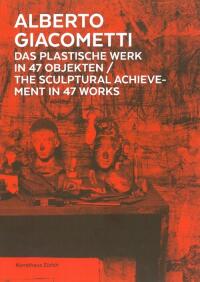Alberto Giacometti. Material und Vision. Die Meisterwerke in Gips, Stein, Ton …
28.10.2016 – 15.01.2017
Curated by Philippe Büttner.
Location Pfister-Bau (Grosser Ausstellungssaal, ehem. Bührlesaal).
Curated by Philippe Büttner.
Location Pfister-Bau (Grosser Ausstellungssaal, ehem. Bührlesaal).
Alberto Giacometti up close
Full title
Alberto Giacometti. Material und Vision. Die Meisterwerke in Gips, Stein, Ton und BronzeFor the fiftieth anniversary of the death of Alberto Giacometti (b. 1901 Borgonovo, Graubunden, d. 1966 Chur) the Kunsthaus Zürich used its large hall to install a wide-ranging exhibition of 250 works in plaster, bronze, clay, stone, wood and plasticine. The Neue Zürcher Zeitung called the show a ‘blockbuster’. The starting point was formed by 75 works in plaster, which had almost never been seen before. In 2006 they had been bequeathed by Bruno Giacometti, the artist’s youngest brother, to the Alberto Giacometti Foundation, which is domiciled in the Kunsthaus, and where they were researched and restored over four years. Since 1965 many works by Giacometti have been held by this foundation, which was established during the artist’s lifetime, at the urging of the industrialist Hans C. Bechtler.
The special situation in Giacometti’s tiny atelier in the Rue Hyppolite Maindron in Paris stimulated the collection’s conservator Philippe Büttner to a special kind of presentation. In Giacometti’s atelier, in the most compact space, there was a dense juxtaposition of works in a wide range of materials and conditions of origin. This density was copied by the staging of the exhibition: At its center were the works revised by Giacometti’s own hands. In the large exhibition hall, more than a hundred plaster works could be seen arranged in loose groups, including also works on loan from the Fondation Alberto et Annette Giacometti in Paris. Plaster models for bronzes for the Chase Manhattan Plaza, which had been sawn apart for the casting process, could also be admired. In addition, there were a few works in clay, which had been preserved because they had not been cast in plaster. The bronzes, which were made in foundries from the 1940s on, were freely placed nearby. The exhibition was extended with paintings by the artist and by his father Giovanni.
This method of presentation was a win for the public. In the Sunday edition of the Neue Zürcher Zeitung, Gerhard Mack put it in a nutshell: ‘His work seems contemporary … Exhibition viewers have not been able to approach this seemingly unapproachable artist so closely for a long time.’
[Peter Stohler]
Further information
no exhibition catalog online
'His work seems contemporary … Exhibition viewers have not been able to approach this seemingly unapproachable artist so closely for a long time.'
79 days
4 Artists
4 Artists

1/10
exhibition catalog

2/10
exhibition view
Ausstellungsansichten Kunsthaus Zürich 2016–2022 © FBM Studio, Zürich
Ausstellungsansichten Kunsthaus Zürich 2016–2022 © FBM Studio, Zürich

3/10
exhibition view
Ausstellungsansichten Kunsthaus Zürich 2016–2022 © FBM Studio, Zürich
Ausstellungsansichten Kunsthaus Zürich 2016–2022 © FBM Studio, Zürich

4/10
exhibition view
Ausstellungsansichten Kunsthaus Zürich 2016–2022 © FBM Studio, Zürich
Ausstellungsansichten Kunsthaus Zürich 2016–2022 © FBM Studio, Zürich

5/10
exhibition view
Ausstellungsansichten Kunsthaus Zürich 2016–2022 © FBM Studio, Zürich
Ausstellungsansichten Kunsthaus Zürich 2016–2022 © FBM Studio, Zürich

6/10
exhibition view
Ausstellungsansichten Kunsthaus Zürich 2016–2022 © FBM Studio, Zürich
Ausstellungsansichten Kunsthaus Zürich 2016–2022 © FBM Studio, Zürich

7/10
exhibition view
Ausstellungsansichten Kunsthaus Zürich 2016–2022 © FBM Studio, Zürich
Ausstellungsansichten Kunsthaus Zürich 2016–2022 © FBM Studio, Zürich

8/10
exhibition view
Ausstellungsansichten Kunsthaus Zürich 2016–2022 © FBM Studio, Zürich
Ausstellungsansichten Kunsthaus Zürich 2016–2022 © FBM Studio, Zürich

9/10
exhibition view
Ausstellungsansichten Kunsthaus Zürich 2016–2022 © FBM Studio, Zürich
Ausstellungsansichten Kunsthaus Zürich 2016–2022 © FBM Studio, Zürich

10/10
exhibition view
Ausstellungsansichten Kunsthaus Zürich 2016–2022 © FBM Studio, Zürich
Ausstellungsansichten Kunsthaus Zürich 2016–2022 © FBM Studio, Zürich
1/10